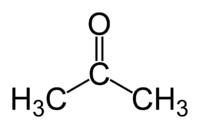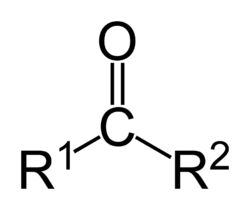Ketone
A ketone (pronounced as key tone) is either the functional group characterized by a carbonyl group (O=C) linked to two other carbon atoms or a chemical compound that contains this functional group. A ketone can be generally represented by the formula:
A carbonyl carbon bonded to two carbon atoms distinguishes ketones from carboxylic acids, aldehydes, esters, amides, and other oxygen-containing compounds. The double-bond of the carbonyl group distinguishes ketones from alcohols and ethers. The simplest ketone is acetone (also called propanone).
The carbon atom adjacent to a carbonyl group is called the α-carbon. Hydrogens attached to this carbon are called α-hydrogens. In the presence of an acid catalyst the ketone is subjected to so-called keto-enol tautomerism. The reaction with a strong base gives the corresponding enolate. A diketone is a compound containing two ketone groups.
Nomenclature

In general, ketones are named using IUPAC nomenclature by changing the suffix -e of the parent alkane to -one. For common ketones, some traditional names such as acetone and benzophenone predominate, and these are considered retained IUPAC names,[1] although some introductory chemistry texts use names such as propanone.
Oxo is the formal IUPAC nomenclature for a ketone functional group. However, other prefixes are also used by various books and journals. For some common chemicals (mainly in biochemistry), keto or oxy is the term used to describe the ketone (also known as alkanone) functional group. Oxo also refers to a single oxygen atom coordinated to a transition metal (a metal oxo).
Physical properties
A carbonyl group is polar. This makes ketones polar compounds. The carbonyl groups interact with water by hydrogen bonding, and ketones are soluble in water. It is a hydrogen-bond acceptor, but not a hydrogen-bond donator, and cannot hydrogen-bond to itself. This makes ketones more volatile than alcohols and carboxylic acids of similar molecular weight.
Acidity
The α-hydrogen of a ketone is far more acidic (pKa â 20) than the hydrogen of a regular alkane (pKa â 50). This is due to resonance stabilization of the enolate ion that is formed through dissociation. The relative acidity of the α-hydrogen is important in the enolization reactions of ketones and other carbonyl compounds.
Spectroscopic properties
Spectroscopy is an important means for identifying ketones. Ketones and aldehydes will display a significant peak in infrared spectroscopy, at around 1700 centimetersâ1 (slightly higher or lower, depending on the chemical environment)
Synthesis
Several methods exist for the preparation of ketones in the laboratory:
- Ketones can be created by oxidation of secondary alcohols. The process requires a strong oxidizing agent such as potassium permanganate, potassium dichromate or other agents containing Cr(VI). The alcohol is oxidized by heating under reflux in acidified solution. For example propan-2-ol is oxidised to propanone (acetone):
- H3C-CH(OH)-CH3 â H3C-CO-CH3
- Two atoms of hydrogen are removed, leaving a single oxygen atom double-bonded to a carbon atom.
- Ketones are also prepared by Gem halide hydrolysis.
- Alkynes can be turned into enols through hydration in the presence of an acid and HgSO4, and subsequent enol-keto tautomerization gives a ketone. This always produces a ketone, even with a terminal alkyne, and Sia2BH is needed to get an aldehyde from an alkyne
- Aromatic ketones can be prepared in the Friedel-Crafts reaction and the Fries rearrangement.
- In the KornblumâDeLaMare rearrangement ketones are prepared from peroxides and base
- In the Ruzicka cyclization, cyclic ketones are prepared from dicarboxylic acids.
- In the Nef reaction, ketones form by hydrolysis of salts of secondary nitro compounds
Reactions
Ketones engage in many organic reactions:
- Nucleophilic addition. The reaction of a ketone with a nucleophile gives a tetrahedral carbonyl addition compound.
- the reaction with the anion of a terminal alkyne gives a hydroxyalkyne
- the reaction with ammonia or a primary amine gives an imine + water
- the reaction with secondary amine gives an enamine + water
- the reaction with a Grignard reagent gives a magnesium alkoxide and after aqueous workup a tertiary alcohol
- the reaction with an organolithium reagent also gives a tertiary alcohol
- the reaction with an alcohol, an acid or base gives a hemiketal + water and further reaction with an alcohol gives the ketal + water. This is a carbonyl-protecting reaction.
- Electrophilic addition, reaction with an electrophile gives a resonance stabilized cation.
- the reaction with phosphonium ylides in the Wittig reaction gives alkenes
- reaction with water gives geminal diols
- reaction with thiols gives a thioacetal
- reaction with hydrazine or derivatives of hydrazine gives hydrazones
- reaction with a metal hydride gives a metal alkoxide salt and then with water an alcohol
- reaction of an enol with halogens to α-haloketone
- a reaction at an α-carbon is the reaction of a ketone with heavy water to give a deuterated ketone-d.
- fragmentation in photochemical Norrish reaction
- reaction with halogens and base of methyl ketones in the Haloform reaction
- reaction of 1,4-aminodiketones to oxazoles by dehydration in the Robinson-Gabriel synthesis
- reaction of aryl alkyl ketones with sulfur and an amine to amides in the Willgerodt reaction
Ketones in biology
Acetone, acetoacetate and beta-hydroxybutyrate are ketones (or ketone bodies) generated from carbohydrates, fatty acids and amino acids in humans and most vertebrates. Ketones are elevated in blood after fasting including a night of sleep, and in both blood and urine in starvation, hypoglycemia due to causes other than hyperinsulinism, various inborn errors of metabolism, and ketoacidosis (usually due to diabetes mellitus). Although ketoacidosis is characteristic of decompensated or untreated type 1 diabetes, ketosis or even ketoacidosis can occur in type 2 diabetes in some circumstances as well. Acetoacetate and beta-hydroxybutyrate are an important fuel for many tissues, especially during fasting and starvation. The brain, in particular, relies heavily on ketone bodies as a substrate for lipid synthesis and for energy during times of reduced food intake. At the NIH, Richard Veech refers to ketones as "magic" in their ability to increase metobolic efficiency, while decreasing production of free radicals, the damaging byproducts of normal metabolism. His work has shown that ketone bodies may treat neurological diseases such as Alzheimer's and Parkinson's disease,[2] and the heart and brain operate 25 percent more efficiently using ketones as a source of energy.[2]
Applications
Ketones are often used in perfumes and paints to stabilize the other ingredients so that they don't degrade as quickly over time. Other uses are as solvents and intermediates in chemical industry. Examples of ketones are Acetophenone, Butanone (methyl ethyl ketone) and Propanone (acetone).
See also
Notes
- â Table 27(a) Carbonyl compounds and derived substituent groups. Parent structures. IUPAC Commission on Nomenclature of Organic Chemistry. Retrieved June 29, 2007.
- â 2.0 2.1 Yoshishiro Kashiwaya, et al (1994), âControl of Glucose Utilization in Working Perfused Rat Heart,â Journal of Biological Chemistry 269 (41): 25502-25514.
ReferencesISBN links support NWE through referral fees
- McMurry, John. 2004. Organic Chemistry, 6th ed. Belmont, CA: Brooks/Cole. ISBN 0534420052
- Morrison, Robert T., and Robert N. Boyd. 1992. Organic Chemistry, 6th ed. Englewood Cliffs, NJ: Prentice Hall. ISBN 0136436692
- Solomons, T.W. Graham, and Craig B. Fryhle. 2004. Organic Chemistry, 8th ed. Hoboken, NJ: John Wiley. ISBN 0471417998
External links
All links retrieved March 2, 2025.
- Ketones: IUPAC Compendium of Chemical Terminology - the Gold Book â International Union of Pure and Applied Chemistry
| Functional groups |
|---|
| Chemical class: Alcohol ⢠Aldehyde ⢠Alkane ⢠Alkene ⢠Alkyne ⢠Amide ⢠Amine ⢠Azo compound ⢠Benzene derivative ⢠Carboxylic acid ⢠Cyanate ⢠Ester ⢠Ether ⢠Haloalkane ⢠Imine ⢠Isocyanide ⢠Isocyanate ⢠Ketone ⢠Nitrile ⢠Nitro compound ⢠Nitroso compound ⢠Peroxide ⢠Phosphoric acid ⢠Pyridine derivative ⢠Sulfone ⢠Sulfonic acid ⢠Sulfoxide ⢠Thioether ⢠Thiol ⢠Toluene derivative |
Credits
New World Encyclopedia writers and editors rewrote and completed the Wikipedia article in accordance with New World Encyclopedia standards. This article abides by terms of the Creative Commons CC-by-sa 3.0 License (CC-by-sa), which may be used and disseminated with proper attribution. Credit is due under the terms of this license that can reference both the New World Encyclopedia contributors and the selfless volunteer contributors of the Wikimedia Foundation. To cite this article click here for a list of acceptable citing formats.The history of earlier contributions by wikipedians is accessible to researchers here:
The history of this article since it was imported to New World Encyclopedia:
Note: Some restrictions may apply to use of individual images which are separately licensed.
